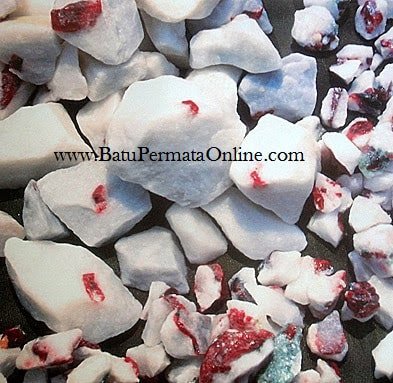Ruby or Red ruby stone mining started 2,500 years ago, and until recently, ruby mining | pomegranate red is still practiced in parts of Asia such as Thailand and Burma, Australia, Pakistan, Afghanistan and the United States. But Burma, now known as Myanmar, is the most famous source of the clearest Ruby. Studies show that the mining of pomegranate in Burma can be used to trace the Stone Age and Bronze Age, as evidenced by the tools found in mining areas. Thailand, on the other hand, is today considered the most important trading center in the world when there is a ruby ruby gem trade. There is also the discovery of pomegranate stone in some areas of Vietnam and the last in Madagascar.
Ruby Rubber Production Areas (Mogok Valley)
Ruby Stone has long been known as one of the rarest and most precious of all gemstones. Admired for its ruggedness and brilliance, with a bright red color. The most valuable Ruby stones are those of the Burmese state, now known as Myanmar. The region famous for the very best Rubi stone is Mogok Valley, located about 200 km northeast of Mandalay in north-central Burma. Related to this it is believed that Ruby mining in this region has been active for more than 1000 years, and this is the rare source of Ruby "Pigeon's Blood". The best Burmese Ruby stones have high intensity of color and fluorescent qualities, where gems really appear to shine. Some excellent specimens also have a velvety softness due to the small inclusion of rutile known as "silk" in the trade.
The Upper Burma Valley of Burma for centuries is the main source of rubies in the world. The area has produced some remarkable rubies, but in recent years some good rubies have been found. In central Myanmar, Mong Hsu area began producing rubies during the 1990s and quickly became the world's premier ruby mining area. The most recent ruby deposit found in Myanmar is in Namya (Namyazeik) located in the northern state of Kachin.
Historically, Ruby Stones have also been mined in Thailand, in the Pailin and Samlout districts of Cambodia, as well as in Afghanistan, Australia, Brazil, Colombia, India, Namibia, Japan, and Scotland; after the ruby deposits of World War II were found in Madagascar, Nepal, Pakistan, Tajikistan, Tanzania, and Vietnam. In Sri Lanka, lighter ruby shades (often "pink sapphires") are more common. The Republic of Macedonia is the only country in mainland Europe that has a natural ruby. They can mainly be found around the city of Prilep. Macedonian Ruby Stone has a unique raspberry color. Rubies are also included in the Macedonian weapon symbol. Some rubies have been found in U.S. state. in Montana, North Carolina, South Carolina and Wyoming.

Rough Ruby Mine in Mong Hsu (Burma)
Most of the current Burmese Ruby stones are found from different locations, ie from Mong Hsu, Shan. Mong Hsu's deposit was discovered only in 1992, the deposit was so great and was considered the most important discovery of Ruby Burma for thousands of years. But Rubi Mong Hsu does not have the same qualities as the famous Ruby Strike rock, they have a tendency to hue that is slightly bluish or purplish and unattractive. The color can be enhanced by heat treatment or heat treatment, so almost all Ruby Mong Hsu in the market has been treated. Before the discovery of Rubi Mong Hsu's deposit, there was a long period when almost all of the world's supply of Ruby came from locations outside of Burma. In 1962 there was a military coup in Burma led by Ne Win, and the government of the military junta took over the Ruby Mogok mine. The Burmese region has barely closed for decades. There is a tight trade embargo and restrictions on human rights abuses there, and some countries, especially the United States, ban any exports from this area. The world is forced to find another place for Ruby, and they seem to turn to Thailand, because Thailand has the largest inventory of facetable materials.